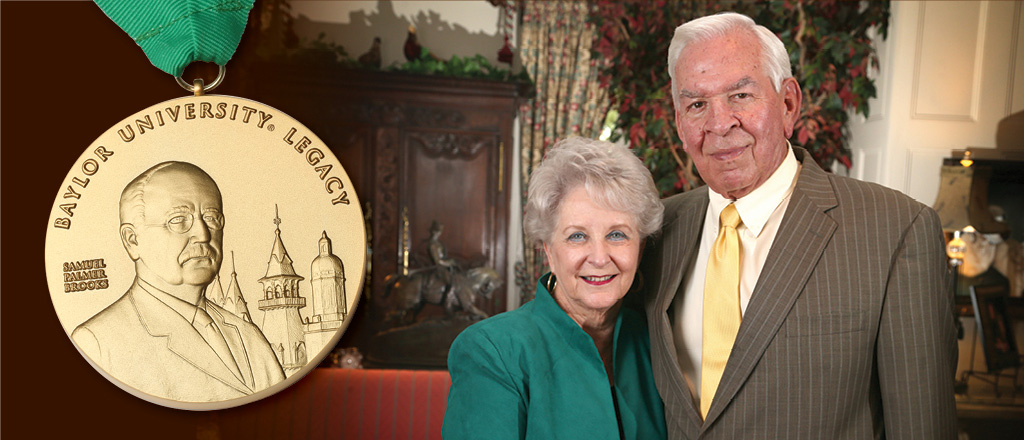Baylor Legacy Award: Walter and Sheila Umphrey

Awarded to individuals who demonstrate extraordinary service and philanthropy to Baylor or to causes that fit our mission as a Christian university
The foundation for Walter Umphrey’s, BBA ’59, JD ’65, legendary law career was built in the wee hours and early mornings in a small home he and his wife Sheila rented from Baylor while he pursued his Baylor law degree.
It was the beginning of a relationship between the Umphreys and Baylor that would eventually grow into foundational support for a stunning home for Baylor Law—and an impressive pedestrian bridge to extend campus north of the Brazos River.
“We were making $245 a month from Sheila’s job at a bank, and we borrowed all the money for tuition,” says Walter, remembering his days and long nights as a law student. “When I got home from law school each day, I’d take a nap for about an hour, pick her up at the bank and then stay up all night studying.”
The focus of Walter’s nocturnal study sessions was Practice Court, which remains one of the most rigorous and respected attributes of a Baylor Law School education. The prospect of facing simulated trials with judge and jury, in front of his professors and peers, was intensely intimidating, Walter remembers. “The image and reputation it had was amazing. It’s like you’d been to court. It would start at 7 o’ clock in the morning and you got to know your way around a courthouse through that real fast.”
The skills honed in that simulated courtroom helped him become one of the true giants in the legal field. In 1969, he formed Provost Umphrey Law Firm, a firm that built a reputation for helping individuals from its home in Beaumont. His greatest victory in that role secured the largest civil settlement in U.S. history. As the lead attorney of a five-man “dream team,” which included fellow Baylor law grads John Eddie Williams,
BBA ’76, JD ’78, and Harold Nix, JD ’65, Umphrey engineered an historic $17.3 billion dollar settlement for Texas residents against the tobacco industry in 1998. The case was emblematic of Umphrey’s passion for serving people, rather than companies, in need of representation.
“What I’ve enjoyed most has been building the law firm I built and helping the people we do,” Walter says. “We don’t represent the big corporations. We help people. That’s what I’m most proud of.”
Today, Provost Umphrey employs more than 20 lawyers, with many of those holding Baylor Law School degrees. Those hires are based on more than school pride. Remembering well how Baylor prepared him for his own career, he recognizes that attorneys who came through the Baylor Law School program “know what a courthouse is and can try a lawsuit. Those students have been given personal attention and received a great education.”
Even after a career that includes one of the greatest legal victories of all time, the Umphreys still find themselves remembering their time in Waco as an idyllic season in their lives. The group of Baylor Law School students, many of whom had little disposable income as they pursued their law degree, developed friendships that last to this day. They often spent time at each other’s homes, sharing in the escape from the rigors of law school life.
“Walter and I had to depend on each other, and they were some of the best years we ever had,” Sheila remembers. “We couldn’t do anything except be with each other and our friends from the law school. The law school was small, and about all of us were friends. We’d go to football and basketball games together or have a barbecue. It was a fun time.”
Their appreciation for Baylor since those days on campus is made manifest through their visionary philanthropy. In 1998, the Umphreys joined with fellow “dream team” lawyers John Eddie Williams and Harold Nix in a gift to fund construction to move Baylor Law School out of Morrison Constitution Hall and into the Sheila and Walter Umphrey Law Center along the Brazos River. The center carries their name in honor of their commitment, which was the largest in school history at the time. The state-of-the-art center more than doubled the space available to Baylor Law students and faculty and set the stage for Baylor Law to remain among the top programs in the nation.
In 2012, the Umphreys once again expanded Baylor’s presence along the river, funding the bridge that connects McLane Stadium to the campus. The Sheila and Walter Umphrey Pedestrian Bridge runs alongside the Umphrey Law Center, expanding the borders of Baylor University north of the Brazos.
Their philanthropy also touches individual Baylor students through endowed scholarships and The Walter Umphrey Endowed Courtroom Fund for the benefit of Baylor Law School.
“Usually, students who need and receive the scholarships are ones that will use the funds to become as good as they can be, because they wouldn’t have been able to attend otherwise,” Sheila says. “They want to stand out and become great lawyers, and we’re glad we are in a position to do what we can to help them.”
For Walter and Sheila, giving to Baylor University and their community along the Texas Gulf Coast is a chance to invest in places that invested so much in them, with the hope that their gifts will make a meaningful difference. Their extensive support for Lamar University in Beaumont, Sheila’s alma mater, includes the lead gift for the Sheila Umphrey Recreational Sports Center. Their philanthropy has also provided for the Walter Umphrey Cancer Center of Southeast Texas and Walter Umphrey State Park in Port Arthur.
“When they dedicated the new law school building,” Sheila remembers, “Walter says to me, ‘You’ve got to get up and say something.’ And what I thought of was, ‘You dance with the one that brung ya.’ We’re thrilled to give back to the ones who gave so much to us.”